ABSTRACT
The project was conducted by Feng Chia University of Taiwan in partnership with the local community at Manado slaughterhouse Bailang Village, Manado city, Indonesia. Bailang Village is located at the suburbs with area of 4.52 km2. The population of Bailang Village is around 7,500 people. A biogas production was socially advantageous for rural development. These advantages include job opportunities, knowledge and technology transfer, economic growth and increased energy security for rural communities. The biogas production plant has evolved as a new technology in Manado. It has made an impact on the social and economic life, and resulted in job creation and education. It is suggested to the Indonesian government to set up a regulation for each city or sub-district that has slaughterhouses to build biogas plants so that slaughterhouse wastes can be used as feedstock to produce biogas that will benefit the surrounding communities. In addition, with biogas plant, slaughterhouses can do waste management. Another suggestion, to the Indonesian government is to set up the regulation for the content of metal component of the biogas effluent, so that the fertilizer that is produced can be used safely for agriculture farming. At the same time, this activity also supports the USR program of Feng Chia University. The importance of higher education can be expressed well through academic services offered to the community.
INTRODUCTION
Indonesia is one of the most diversified countries in the world. There are approximately 17,000 islands in Indonesia, the five big ones are Sumatra, Kalimantan, Sulawesi, Papua, and Java islands. Indonesia consists of two major parts, the Western and Eastern parts, in which the development in western part is more advanced compared to that of eastern part. This story focused on the community in Manado city, situated in north part of Sulawesi Island, one of the islands in the eastern part of Indonesia. The development of Indonesia’s western part is faster than its eastern counterpart, hence, the community poverty level is higher at the eastern part compared to the western part of the country (Resosudarmo and Miranti, 2004).
According to Indonesia’s National Energy Policy established through Governmental Regulation No. 79 of 2014, renewable energy is targeted to achieve 23% of Indonesia’s total energy mix by 2025. Indonesia’s National Development Planning Agency formulated policy in order to reduce greenhouse gases in the country. It was stated in Article 6 paragraph (1) of Presidential Regulation of the Republic of Indonesia Number 61 Year 2011 on the National Action Plan for Greenhouse Gas Emission Reduction, that to reduce the Greenhouse Gas emissions in each province, the Governor of each province should compose the Regional Action Plan for Greenhouse Gas Emissions Reduction (RAD GRK). To achieve the target, RAD GRK needs to be supported by the local government, the private sector and communities. In addition, the President of the Republic of Indonesia committed to reduce greenhouse gases 26% by 2020 by national effort and another 15% by international support (dan Kementerian and Nasional, 2011).
The utilization of new and renewable energy such as sunlight, wind, tides, etc., in Indonesia is mostly for electricity, while other new and renewable energy resources such as biofuel, biogas and biomass are used for households, commercial and industry to reduce fossil energy consumption. Energy security could be defined as the impartial establishment of availability, affordability, reliability, efficiency, environmental benevolence, proactively governance and socially acceptability of energy services to end–users (Sovacool et al. , 2011). Energy diversification is one of the solutions to the energy crisis threat in Indonesia. Conservation could be done through energy saving and developing renewable energy sources, which of course, should be supported by the government policies, which are environment-conscious. Bioenergy will be one of the main options to meet this target. Indonesia has abundant resources of organic feedstock, such as animal manure and crop wastes since agriculture is a key economic sector in Indonesia (dan Kementerian and Nasional, 2011). Environmental impacts of agricultural production systems have gained importance in the last decade from the national as well as the international points of view. The agricultural industry produces organic waste which contributes to global warming and climate change. Biogas can be produced from animal wastes, organic wastes from homes and traditional markets. Biogas is an alternative and clean energy that can be used to replace fossil fuels and to enhance energy security worldwide. Biogas is comparable to natural gas and is a potentially prominent energy source for heat, electricity and fuel production. The conversion of organic matter into biogas is carried out by a consortium of microorganisms through a series of metabolic stages, namely, hydrolysis, acidogenesis, acetogenesis and methanogenesis. In the first step, complex organic compounds such as lipids, proteins, and poly saccharides are converted into soluble monomers or oligomers (e.g. amino acids, long chain fatty acids, sugars and glycerol) through hydrolysis, also known as liquefaction. This process is facilitated by hydrolytic or fermentative bacteria that release extra cellular enzymes. The percentage of volume of methane in biogas varies between 50 to 72%. For the operation of power generation with biogas, a minimum concentration of methane of 40 to 45% is needed. The second main component of biogas is carbon dioxide. Its composition in biogas reaches between 25 and 50% of volume. Other gases present in biogas are hydrogen sulfide, nitrogen, hydrogen and steam (Jørgensen, 2009).
As an innovation, the biogas technology was introduced in Indonesia around 1970 and had largely been disseminated since 1980 by the Ministry of Agriculture, Indonesia (Widodo et al. , 2009). Both private and public sector have participated in the development of the technology for more than the last 30 years. The uses of biogas also can reduce atmospheric greenhouse gases and other emissions. Several factors that affect the production of biogas are the condition of the digester, pH, nutrients, temperature, the ratio C/N, and feedstock. The optimum temperature needed for microorganisms to break down the material is 30-38°C for mesophilic and 49-57°C for thermophilic. Feedstock is a very important part that supports the production of biogas. It is used to accelerate the reform process of organic materials. Common feedstock used in biogas production are activated sludge or the content of rumen fluid (Widarto, 1997, Widodo et al. , 2006).
The project model was conducted by Feng Chia University of Taiwan in partnership with the local community at Manado slaughterhouse Bailang village, Manado city, Indonesia (Fig. 1). Bailang village is located at suburbs with an area of 4.52 km2. The population of Bailang Village is around 7,500 people, divided into 2,000 households (Manado, 2020). The main occupation of the population is farming and cattle ranching. Among the 2,000 households, 10% of them do not yet have an electricity connection. This is due to the lack of availability of electricity connection infrastructure in the suburban areas of Manado. Besides that, to get clean water, people have to take water manually from wells because to operate a submersible pump depends on the electrical connection. A number of flood victims who lost their homes in 2014 were relocated to the Bailang village.
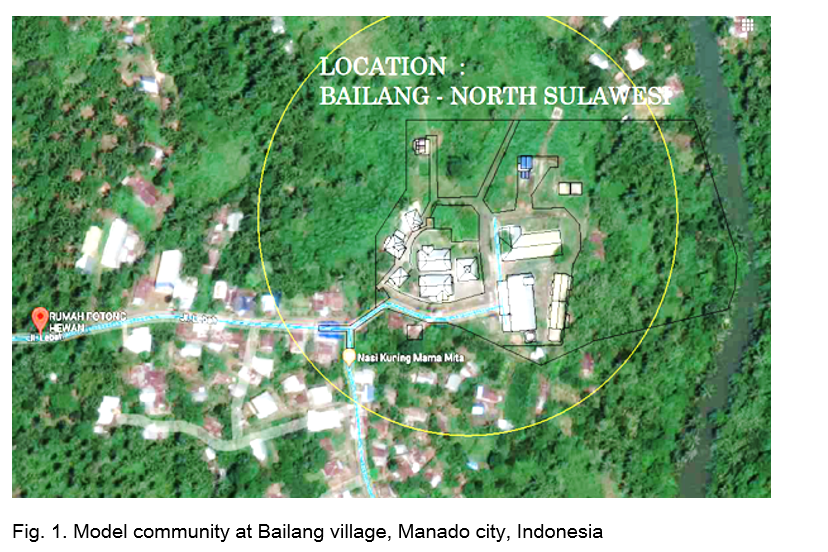
For this project we met the Head and staff of the Manado Regional Planning and Development Board of Manado city government to gather some information, and had some interviews about the city plan on the slaughterhouse location after the implementation of biogas production plant. The Manado city government through Regional Planning and Development Board had planned to develop the biogas production plant in slaughterhouse area to be a Bioenergy Education House (Fig. 2).
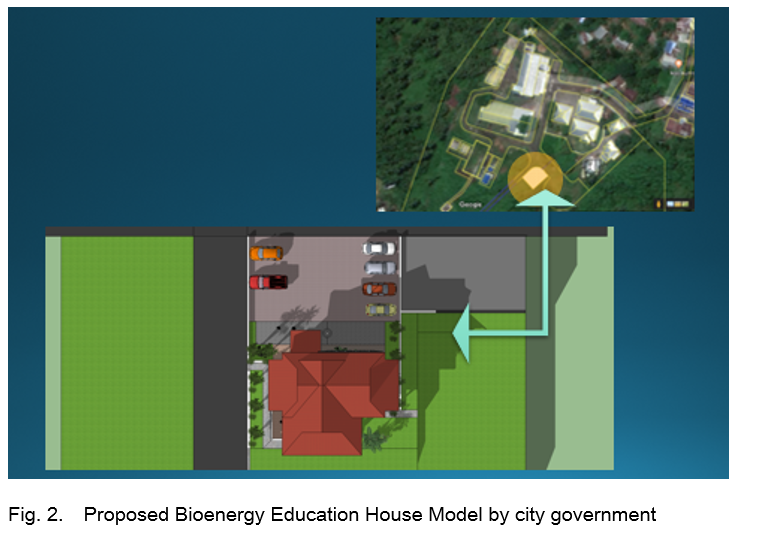
SOCIAL AND ECONOMY IMPACTS
Sustainability has been a core conceptual framework for community development. Sustainability continues to maintain a dominant role as the preferred development paradigm for most policy and program actions taken by governments, communities, and businesses. It is usually mentioned that renewable energy sources have a large potential to contribute to the sustainable development of specific territories by providing them with a wide variety of socioeconomic benefits, including diversification of energy supply, enhanced regional and rural development opportunities, increasing knowledge and job creation opportunities. A biogas production can be socially advantageous for rural development. These advantages include job opportunities, knowledge and technology transfer, economic growth and increased energy security for rural communities.
The University Social Responsibility (USR), is a principle for social relevance, which can be perceived as a philosophy of a university which is used as an ethical approach in the development and engagement with the locals in the community in order to sustain their social, ecological, environmental, technical, and economic development (De Ketele, 2009). The importance of higher education can be expressed well through academic services offered to the community. The community is the target of educational services through various platforms with environmental, economic, and social modes. Education is the main key in developing the community’s sustainability through USR program. This is done through the responsible management of the educational cognitive, knowledge, and environmental impact from the university, in an active collaboration with society and its communities, in order to promote sustainable human development through education (transforming knowledge), provision of services, research, and teaching. Social engagement has become one of the fundamental pillars of universities. Hence, social service is considered as a core mission that equals to teaching and research. Accordingly, the concept of ethics and Social Responsibility need to be introduced in the teaching and learning process as the “Think Globally, Act Locally” approach by Patrick Geddes (Geddes, 2010). It should be embedded as part of the university’s philosophy as a way of being, operating, and practicing, ensuring that the Sustainable Development Goals (SDGs) can be met.
One of the USR activities carried out by Feng Chia University is sending PhD students to Manado, North Sulawesi, Indonesia to share knowledge and technology with the public. Why was the city of Manado chosen? Because Manado is the city that had been chosen by APEC Research Center for Advanced Biohydrogen Technology (APEC ACABT) in 2018 when they were implementing the Demo & Training Center of Two-stage Biohythane (HyMeTek) system. It is a biogas generation system that uses renewable energy biomass and organic waste as the resource. The technology of HyMeTek is coming from Feng Chia University that collaborates with APEC ACABT to share the knowledge and technology for people in Indonesia, especially in Manado city. First and foremost, what is urgently needed is a major shift in mindsets and attitudes. Schools and universities need to go back to their original foundational purpose – to educate, shape minds, inculcate the right values and develop good citizens who then go on to become change makers that positively impact the world around them and reaching towards the Sustainable Development Goals as the objective.
In the summer school holiday on August 1st to August 30th, 2019, Feng Chia University had sent three students – one PhD student and two Master students - to Manado city, Indonesia for an internship to follow up and maintain the biogas production plant in Bailang village slaughterhouse. At the same time, this activity also supports the USR program of Feng Chia University. There were few activities that have been held during the visiting period in Manado. These activities were arranged and executed by the students themselves, who worked together with the local institutions. The PhD student had to organize the international lecture about Bioenergy system, and the Master students had to maintain the system in the slaughterhouse. There was some unwanted gas compound such as H2S which were produced in the system besides CH4, O2, N2, H2 and CO2. This H2S had to be removed, because one of its characters is its corrosiveness that may damage the generator. The Master students’ task during the summer internship was to design and assemble the H2S remover using local materials. The PhD student, in collaboration with Eben Haezar Education Foundation Senior High School, held an International Lecture with topic of “Biowaste to Bioenergy for Community Sustainability and Revitalization”, under the USR program entitled “Introduction to the Centralized Biomass Energy System to Promote Sustainable Cycle and Social Creation in the Region.” This international lecture was delivered at the school, and was attended by 165 participants, consisting of students, teachers and local people. The lecture started with some introduction about the Biogas system. By using videos and pictures to make the high school students get more understanding about the knowledge, because, visions will stay longer in mind rather than its oral counterpart. The students were very enthusiastic in following the two-hour lecture, and in finalizing with some questions for feedback. And, those were awesome, because the students can answer all questions, and got the small gifts as presents (Fig. 3). Onsite visit was done the next day after international lecture (Fig. 4). During the site visit, the two Master students explained to the high school students and local people about the removal of H2S gas compound, and how to do it. Both of the Master’s students demonstrated how to use the gas checked equipment and showed them the difference of before and after the installation of H2S removal system in the biogas production plant. For the H2S remover, they used the local material such as PVC and gauze (Fig. 5).
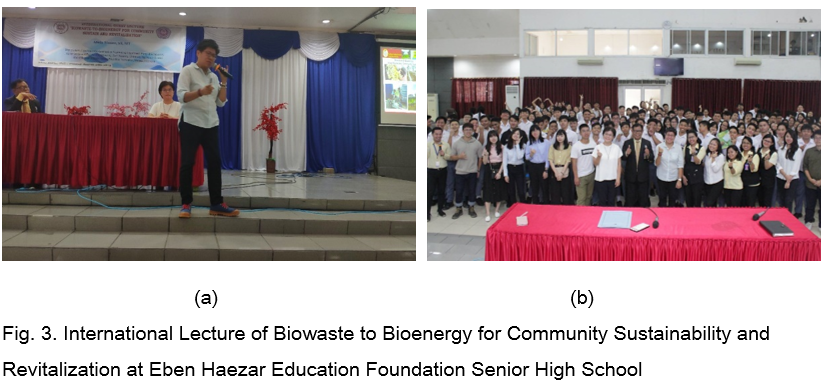

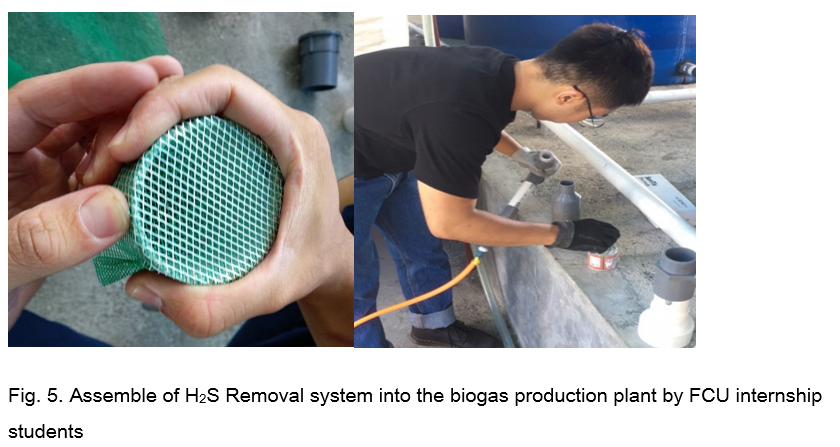
Based on the Memorandum of Understanding (MoU) between Feng Chi University (FCU) and University of Sam Ratulangi (UNSRAT) that was signed in 2018, both universities carried out the research activities which was written in the Memorandum of Agreement (MoA) signed in 2019, in the form of International Joint Research Center (IJRC). The purposes of the research collaboration between FCU and UNSRAT are to promote interest in the multidisciplinary research activities of the respective institutions, and to deepen the understanding at each institution of the technology, knowledge, cultural and social and environmental issues relating to its counterpart. The framework of IJRC organization consists of five Task Forces (TF): Renewable Energy (TF-1), Green Building, Urban Planning and Environmental Impacts (TF-2), Sciences, Agriculture, Animal/Husbandry (TF-3), Education and Training (TF-4) and Economy, Social and Policy (TF-5). The IJRC members are professors from both universities, FCU and Unsrat, and sit in the task force according to their respective fields of expertise. On January 6-7, 2020, IJRC’s first international meeting was held in FCU. It was attended by 16 professors, from FCU and Unsrat (Fig. 6). In this first meeting, a discussion about the possibility of joint research between FCU and UNSRAT focused on developing the Bioenergy demo site at Manado Slaughterhouse as its locus, to support and develop the rural community in Bailang village from the benefits of Bioenergy technology. It is hoped that in the future, this community will become a self-sustained community.
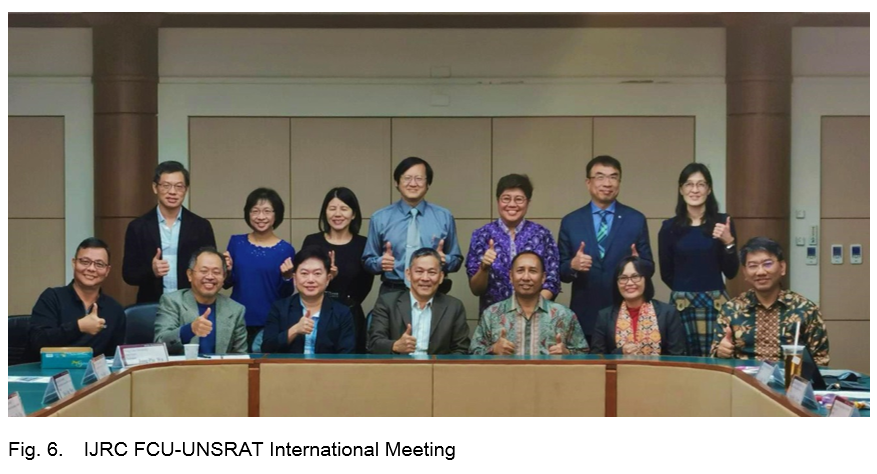
Biofertilizer is one of the outputs from this biogas production plant, besides bioelectricity and biogas. Biofertilizers are the substance that contains microbes, which helps in promoting the growth of plants, by increasing the supply of essential nutrients to the plants. Digestate, which contains all the nutrients of the treated materials, can be used as a fertilizer (Timonen et al. , 2019). The incorporation of organic matter increases the microbiological activity and enhances the plant nutrients of soil. This required an appropriate fertilizer that has minimal impact on the environment and facilitates the efficient recycling of plant nutrients. Biogas waste is free from pathogens and can kill disease-causing organisms. It also maintains soil moisture, and can add topsoil and increase water content in the soil. The anaerobic process of biogas produced digested residues which can be used by farmers at the community to be organic fertilizer (Fig. 7).
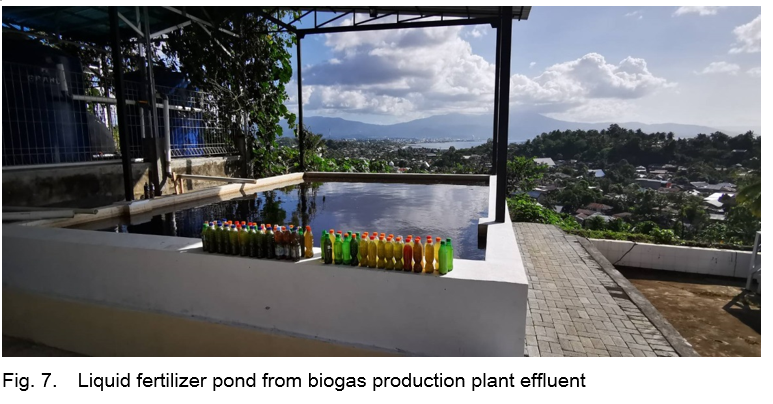
Indonesia is known as a producer of tropical fruits and vegetables. Chili is very popular in Indonesia, especially in Manado city, because it is one of the main ingredients of Manado cuisine. Most of Manado cuisines are spicy and hot. Chilies can be harvested within a short period after planting. It can be harvested during two years, but the productive time of harvesting is one year. Planting chilies is one of the benefits which the community can get, because after harvest, some can sell the product to the market, but some can be used for home consumption. To show the good sample of how good the chili harvest will be by using biofertilizers, an experiment was held using few of chili plants in poly bags (Fig. 8). These chili plants were one month raised in poly bags and put around the demo site. While putting the chili plants around the demo site, the location looked much better, clean and green. We grew all the chili plants by using biofertilizers from the biogas effluent. Every day, the operator had to pour the liquid biofertilizers onto the chili plants. Within two months all the chili plants grew very strong and tall. It has big leaves and abundant chili harvest. We had experienced good harvests ourselves, in February 2020, and we got about five kilograms in the first harvest (Fig. 9).
Our good experiences in chili harvest yield which was given sprayed with organic fertilizer was notable and the community then increased the area of chili plantation in which more chili seeds around the biogas production plant were planted. At the same time the rural community made use of some land spaces that had not been used so far by planting other plantations, such as cassava, papaya and some local vegetables. This also has a good impact for the environment because the community cleaned the unused land. Also, it had a good impact for the community in terms of job creation and economic benefits, where the rural community provided extra jobs and extra income to gain. In addition, the environment is clean and became an interesting place to be visited by visitors (Fig. 10).

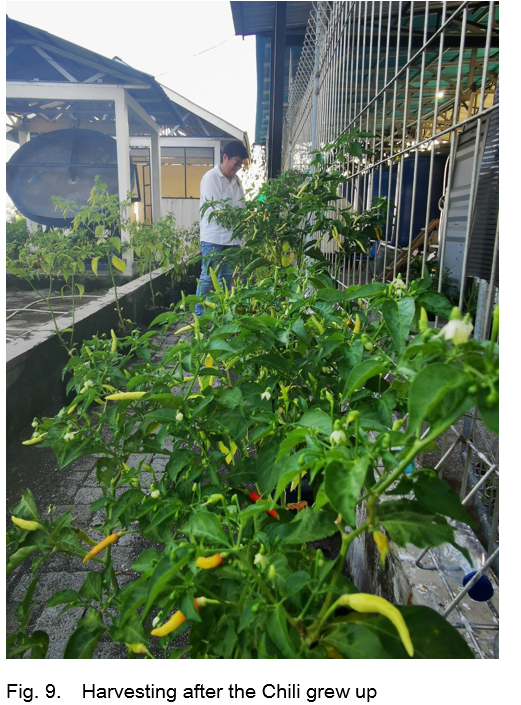

The biogas production plant has evolved as a new technology in Manado. It has impact to the social and economic life, and resulted in job creation and education. It creates job opportunity, by generating substantial skills for the operator system as well as unskilled employment during the process of construction. After construction had been done, it came to the operational stage. In order to run the operation smoothly, we need operators to run and maintain the system, also doing some trouble shoots if problems occur. In November 2018, we recruited two operators to run and maintain the system for daily operation. We held operator training for a week after the recruitment, to prepare these two operators (Fig. 11). They were from the local community who live nearby the slaughterhouse location, so that it will be easier and faster to reach the plant if some problems occur during the system running. As mentioned above, the rural community people in general are low educated and live in poverty line. These two operators also came from poor family and have low education. One graduated from junior high school, and the other one graduated from senior high school. The knowledge of renewable energy especially biogas was very insufficient. But both of them worked very hard and learned quite fast since they were recruited. After few months working as a biogas production plant operator, one of the operators who graduated from high school, enrolled to study in the Engineering Department of a private university in Manado city. This operator is very persistent in learning knowledge about renewable energy, especially biogas. And this triggers a deeper curiosity to master the knowledge through higher institutions. Now he is in the second year of engineering student, and still works as an operator in the slaughterhouse. With his persistence, he learned many things very fast, including trouble shooting to some minor problems at the biogas production plant, and now he also taught some community people the principle of biogas production, and even tried to design the simple house biogas for community’s cooking fuel. Social impacts in education is another benefit of biogas production plant that can be felt by the rural community that created sustained jobs for the people in the community situated nearby the biogas production plant.
Visitors also elicited good impact from this demo site. Students from universities and high school, lecturers, teachers, and other visitors from other local and national institutions came several times to visit and to learn about biogas production technology from this demo site. Approximately 150-200 visitors came to the demo site during the year of 2019. Most of them were interested to learn about the technology, and to look closely at the system. Some lecturers also brought their students to learn by doing in the demo site.
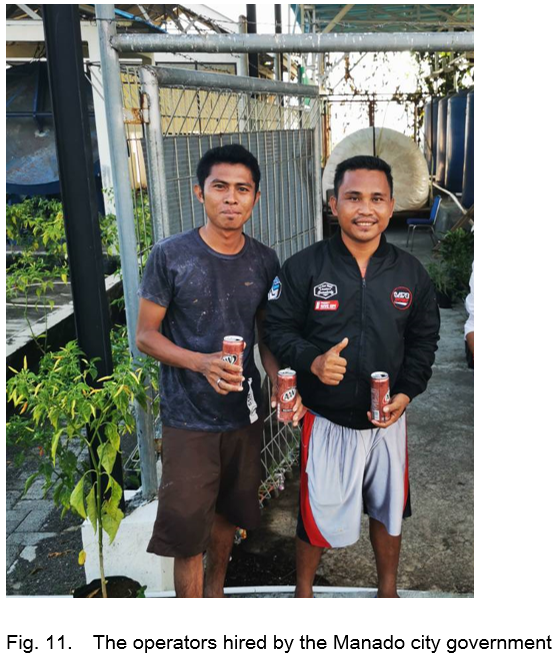
One of them was Prof. Sangkertadi, the No. 4 Vice Rector of University of Sam Ratulangi who are also lecturing about Green Building Science. He brought his 30 students to visit the demo site. He showed his students the condition of the demo site especially the airbag where we collected the biogas, and asked the students to design the biogas storage which was made from stronger local materials (Fig. 12). There were many benefits for the rural community after the installation of biogas production plant. The installation of this plant also resulted in better management and disposal of cow manure and agricultural wastes. The cleanliness and odorless of the slaughterhouse caused more people to come visit and learn. This biogas production plant system became a right concept model for self-sustained community in the rural area.
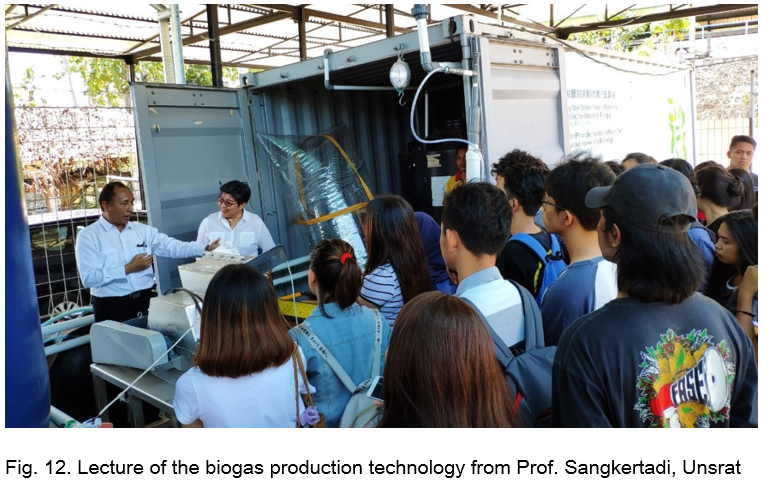
POLICY RECOMMENDATIONS
The biogas production technology development using the slaughterhouse and agricultural wastes in Manado has a good prospect because besides producing bioelectricity, biogas and biofertilizers, it also kept the environment cleaner and odorless, especially for the slaughterhouse. The proposed concept can be adopted to develop rural areas in Indonesia since it encompasses multiple objectives such as enhancing energy, reducing dependence on fossil fuels, alleviating poverty and creating jobs in rural areas.
It is suggested to the Indonesian government to set up a regulation for each city or sub-district that has slaughterhouses to build biogas plants so that slaughterhouse wastes can be used as feedstock to produce biogas that will benefit the surrounding communities. Moreover, with biogas plant, waste management can be done in slaughterhouses. Another suggestion, to the Indonesian government is to set up the regulation for the content of metal component of the biogas effluent, so that the fertilizers that are produced can be used safely for agriculture farming.
REFERENCES
dan Kementerian KKBP, Nasional PP. BAPPENAS, 2011. Master Plan Percepatan dan Perluasan Pembangunan Ekonomi Indonesia (MP3EI). 2011;2025.
De Ketele J. The social relevance of higher education. Higher education at a time of transformation: New dynamics for social responsibility Basingstoke: GUNI/Palgrave Macmillan. 2009.
Geddes P. Cities in Evolution (new York: H. Fertig, 1968). this is the first work to use the phrase “think globally, act locally.”. 2010.
Jørgensen PJ. Biogas-green energy. Faculty of Agricultural Sciences, Aarhus University. 2009.
Manado BPSk. Kota Manado Dalam Angka 2020, Penyediaan Data Untuk Perencanan Pembangunan. In: BPS - Statistics of Manado Municipality I, editor. 1 ed. Manado, Indonesia: BPS Statistics of Manado Municipality; 2020. p. 22.
Resosudarmo BP, Miranti R. Understanding Regional Poverty in Indonesia: Is Poverty Worse in the East Than in the West. The 6th IRSA International Conference, Jogjakarta, Indonesia2004.
Sovacool BK, Mukherjee I, Drupady IM, D’Agostino AL. Evaluating energy security performance from 1990 to 2010 for eighteen countries. Energy. 2011;36:5846-53.
Timonen K, Sinkko T, Luostarinen S, Tampio E, Joensuu K. LCA of anaerobic digestion: Emission allocation for energy and digestate. Journal of cleaner production. 2019;235:1567-79.
Widarto IL. Teknologi Tepat Guna MEMBUAT BIOGAS: Kanisius; 1997.
Widodo TW, Asari A, Ana N, Elita R. Rekayasa dan Pengujian Reaktor Biogas Skala Kelompok Tani Ternak. Jurnal Enjiniring Pertanian. 2006;4:41-52.
Widodo TW, Asari A, Ana N, Elita R. Design and development of biogas reactor for farmer group scale. Indonesian Journal of Agriculture. 2009;2:121-8.
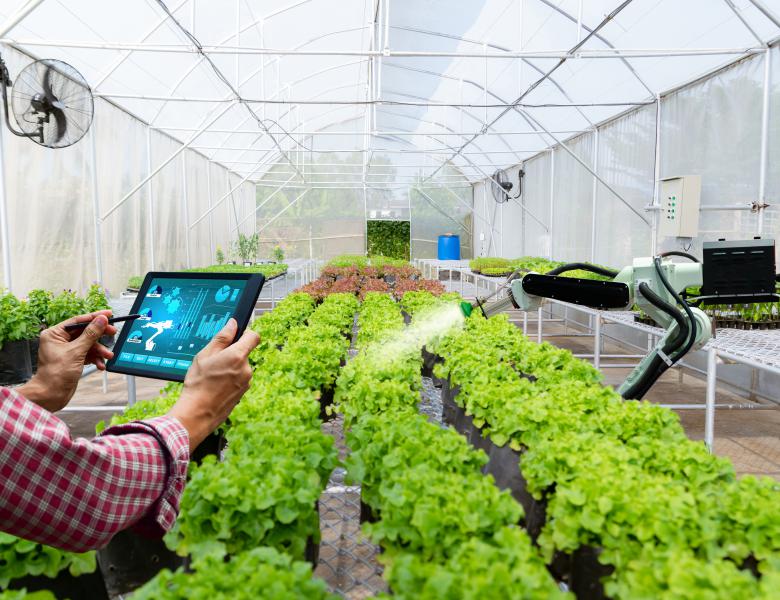


Towards Sustained Community on the Manado Rural Area by Developing Biogas Production Technology
ABSTRACT
The project was conducted by Feng Chia University of Taiwan in partnership with the local community at Manado slaughterhouse Bailang Village, Manado city, Indonesia. Bailang Village is located at the suburbs with area of 4.52 km2. The population of Bailang Village is around 7,500 people. A biogas production was socially advantageous for rural development. These advantages include job opportunities, knowledge and technology transfer, economic growth and increased energy security for rural communities. The biogas production plant has evolved as a new technology in Manado. It has made an impact on the social and economic life, and resulted in job creation and education. It is suggested to the Indonesian government to set up a regulation for each city or sub-district that has slaughterhouses to build biogas plants so that slaughterhouse wastes can be used as feedstock to produce biogas that will benefit the surrounding communities. In addition, with biogas plant, slaughterhouses can do waste management. Another suggestion, to the Indonesian government is to set up the regulation for the content of metal component of the biogas effluent, so that the fertilizer that is produced can be used safely for agriculture farming. At the same time, this activity also supports the USR program of Feng Chia University. The importance of higher education can be expressed well through academic services offered to the community.
INTRODUCTION
Indonesia is one of the most diversified countries in the world. There are approximately 17,000 islands in Indonesia, the five big ones are Sumatra, Kalimantan, Sulawesi, Papua, and Java islands. Indonesia consists of two major parts, the Western and Eastern parts, in which the development in western part is more advanced compared to that of eastern part. This story focused on the community in Manado city, situated in north part of Sulawesi Island, one of the islands in the eastern part of Indonesia. The development of Indonesia’s western part is faster than its eastern counterpart, hence, the community poverty level is higher at the eastern part compared to the western part of the country (Resosudarmo and Miranti, 2004).
According to Indonesia’s National Energy Policy established through Governmental Regulation No. 79 of 2014, renewable energy is targeted to achieve 23% of Indonesia’s total energy mix by 2025. Indonesia’s National Development Planning Agency formulated policy in order to reduce greenhouse gases in the country. It was stated in Article 6 paragraph (1) of Presidential Regulation of the Republic of Indonesia Number 61 Year 2011 on the National Action Plan for Greenhouse Gas Emission Reduction, that to reduce the Greenhouse Gas emissions in each province, the Governor of each province should compose the Regional Action Plan for Greenhouse Gas Emissions Reduction (RAD GRK). To achieve the target, RAD GRK needs to be supported by the local government, the private sector and communities. In addition, the President of the Republic of Indonesia committed to reduce greenhouse gases 26% by 2020 by national effort and another 15% by international support (dan Kementerian and Nasional, 2011).
The utilization of new and renewable energy such as sunlight, wind, tides, etc., in Indonesia is mostly for electricity, while other new and renewable energy resources such as biofuel, biogas and biomass are used for households, commercial and industry to reduce fossil energy consumption. Energy security could be defined as the impartial establishment of availability, affordability, reliability, efficiency, environmental benevolence, proactively governance and socially acceptability of energy services to end–users (Sovacool et al. , 2011). Energy diversification is one of the solutions to the energy crisis threat in Indonesia. Conservation could be done through energy saving and developing renewable energy sources, which of course, should be supported by the government policies, which are environment-conscious. Bioenergy will be one of the main options to meet this target. Indonesia has abundant resources of organic feedstock, such as animal manure and crop wastes since agriculture is a key economic sector in Indonesia (dan Kementerian and Nasional, 2011). Environmental impacts of agricultural production systems have gained importance in the last decade from the national as well as the international points of view. The agricultural industry produces organic waste which contributes to global warming and climate change. Biogas can be produced from animal wastes, organic wastes from homes and traditional markets. Biogas is an alternative and clean energy that can be used to replace fossil fuels and to enhance energy security worldwide. Biogas is comparable to natural gas and is a potentially prominent energy source for heat, electricity and fuel production. The conversion of organic matter into biogas is carried out by a consortium of microorganisms through a series of metabolic stages, namely, hydrolysis, acidogenesis, acetogenesis and methanogenesis. In the first step, complex organic compounds such as lipids, proteins, and poly saccharides are converted into soluble monomers or oligomers (e.g. amino acids, long chain fatty acids, sugars and glycerol) through hydrolysis, also known as liquefaction. This process is facilitated by hydrolytic or fermentative bacteria that release extra cellular enzymes. The percentage of volume of methane in biogas varies between 50 to 72%. For the operation of power generation with biogas, a minimum concentration of methane of 40 to 45% is needed. The second main component of biogas is carbon dioxide. Its composition in biogas reaches between 25 and 50% of volume. Other gases present in biogas are hydrogen sulfide, nitrogen, hydrogen and steam (Jørgensen, 2009).
As an innovation, the biogas technology was introduced in Indonesia around 1970 and had largely been disseminated since 1980 by the Ministry of Agriculture, Indonesia (Widodo et al. , 2009). Both private and public sector have participated in the development of the technology for more than the last 30 years. The uses of biogas also can reduce atmospheric greenhouse gases and other emissions. Several factors that affect the production of biogas are the condition of the digester, pH, nutrients, temperature, the ratio C/N, and feedstock. The optimum temperature needed for microorganisms to break down the material is 30-38°C for mesophilic and 49-57°C for thermophilic. Feedstock is a very important part that supports the production of biogas. It is used to accelerate the reform process of organic materials. Common feedstock used in biogas production are activated sludge or the content of rumen fluid (Widarto, 1997, Widodo et al. , 2006).
The project model was conducted by Feng Chia University of Taiwan in partnership with the local community at Manado slaughterhouse Bailang village, Manado city, Indonesia (Fig. 1). Bailang village is located at suburbs with an area of 4.52 km2. The population of Bailang Village is around 7,500 people, divided into 2,000 households (Manado, 2020). The main occupation of the population is farming and cattle ranching. Among the 2,000 households, 10% of them do not yet have an electricity connection. This is due to the lack of availability of electricity connection infrastructure in the suburban areas of Manado. Besides that, to get clean water, people have to take water manually from wells because to operate a submersible pump depends on the electrical connection. A number of flood victims who lost their homes in 2014 were relocated to the Bailang village.
For this project we met the Head and staff of the Manado Regional Planning and Development Board of Manado city government to gather some information, and had some interviews about the city plan on the slaughterhouse location after the implementation of biogas production plant. The Manado city government through Regional Planning and Development Board had planned to develop the biogas production plant in slaughterhouse area to be a Bioenergy Education House (Fig. 2).
SOCIAL AND ECONOMY IMPACTS
Sustainability has been a core conceptual framework for community development. Sustainability continues to maintain a dominant role as the preferred development paradigm for most policy and program actions taken by governments, communities, and businesses. It is usually mentioned that renewable energy sources have a large potential to contribute to the sustainable development of specific territories by providing them with a wide variety of socioeconomic benefits, including diversification of energy supply, enhanced regional and rural development opportunities, increasing knowledge and job creation opportunities. A biogas production can be socially advantageous for rural development. These advantages include job opportunities, knowledge and technology transfer, economic growth and increased energy security for rural communities.
The University Social Responsibility (USR), is a principle for social relevance, which can be perceived as a philosophy of a university which is used as an ethical approach in the development and engagement with the locals in the community in order to sustain their social, ecological, environmental, technical, and economic development (De Ketele, 2009). The importance of higher education can be expressed well through academic services offered to the community. The community is the target of educational services through various platforms with environmental, economic, and social modes. Education is the main key in developing the community’s sustainability through USR program. This is done through the responsible management of the educational cognitive, knowledge, and environmental impact from the university, in an active collaboration with society and its communities, in order to promote sustainable human development through education (transforming knowledge), provision of services, research, and teaching. Social engagement has become one of the fundamental pillars of universities. Hence, social service is considered as a core mission that equals to teaching and research. Accordingly, the concept of ethics and Social Responsibility need to be introduced in the teaching and learning process as the “Think Globally, Act Locally” approach by Patrick Geddes (Geddes, 2010). It should be embedded as part of the university’s philosophy as a way of being, operating, and practicing, ensuring that the Sustainable Development Goals (SDGs) can be met.
One of the USR activities carried out by Feng Chia University is sending PhD students to Manado, North Sulawesi, Indonesia to share knowledge and technology with the public. Why was the city of Manado chosen? Because Manado is the city that had been chosen by APEC Research Center for Advanced Biohydrogen Technology (APEC ACABT) in 2018 when they were implementing the Demo & Training Center of Two-stage Biohythane (HyMeTek) system. It is a biogas generation system that uses renewable energy biomass and organic waste as the resource. The technology of HyMeTek is coming from Feng Chia University that collaborates with APEC ACABT to share the knowledge and technology for people in Indonesia, especially in Manado city. First and foremost, what is urgently needed is a major shift in mindsets and attitudes. Schools and universities need to go back to their original foundational purpose – to educate, shape minds, inculcate the right values and develop good citizens who then go on to become change makers that positively impact the world around them and reaching towards the Sustainable Development Goals as the objective.
In the summer school holiday on August 1st to August 30th, 2019, Feng Chia University had sent three students – one PhD student and two Master students - to Manado city, Indonesia for an internship to follow up and maintain the biogas production plant in Bailang village slaughterhouse. At the same time, this activity also supports the USR program of Feng Chia University. There were few activities that have been held during the visiting period in Manado. These activities were arranged and executed by the students themselves, who worked together with the local institutions. The PhD student had to organize the international lecture about Bioenergy system, and the Master students had to maintain the system in the slaughterhouse. There was some unwanted gas compound such as H2S which were produced in the system besides CH4, O2, N2, H2 and CO2. This H2S had to be removed, because one of its characters is its corrosiveness that may damage the generator. The Master students’ task during the summer internship was to design and assemble the H2S remover using local materials. The PhD student, in collaboration with Eben Haezar Education Foundation Senior High School, held an International Lecture with topic of “Biowaste to Bioenergy for Community Sustainability and Revitalization”, under the USR program entitled “Introduction to the Centralized Biomass Energy System to Promote Sustainable Cycle and Social Creation in the Region.” This international lecture was delivered at the school, and was attended by 165 participants, consisting of students, teachers and local people. The lecture started with some introduction about the Biogas system. By using videos and pictures to make the high school students get more understanding about the knowledge, because, visions will stay longer in mind rather than its oral counterpart. The students were very enthusiastic in following the two-hour lecture, and in finalizing with some questions for feedback. And, those were awesome, because the students can answer all questions, and got the small gifts as presents (Fig. 3). Onsite visit was done the next day after international lecture (Fig. 4). During the site visit, the two Master students explained to the high school students and local people about the removal of H2S gas compound, and how to do it. Both of the Master’s students demonstrated how to use the gas checked equipment and showed them the difference of before and after the installation of H2S removal system in the biogas production plant. For the H2S remover, they used the local material such as PVC and gauze (Fig. 5).
Based on the Memorandum of Understanding (MoU) between Feng Chi University (FCU) and University of Sam Ratulangi (UNSRAT) that was signed in 2018, both universities carried out the research activities which was written in the Memorandum of Agreement (MoA) signed in 2019, in the form of International Joint Research Center (IJRC). The purposes of the research collaboration between FCU and UNSRAT are to promote interest in the multidisciplinary research activities of the respective institutions, and to deepen the understanding at each institution of the technology, knowledge, cultural and social and environmental issues relating to its counterpart. The framework of IJRC organization consists of five Task Forces (TF): Renewable Energy (TF-1), Green Building, Urban Planning and Environmental Impacts (TF-2), Sciences, Agriculture, Animal/Husbandry (TF-3), Education and Training (TF-4) and Economy, Social and Policy (TF-5). The IJRC members are professors from both universities, FCU and Unsrat, and sit in the task force according to their respective fields of expertise. On January 6-7, 2020, IJRC’s first international meeting was held in FCU. It was attended by 16 professors, from FCU and Unsrat (Fig. 6). In this first meeting, a discussion about the possibility of joint research between FCU and UNSRAT focused on developing the Bioenergy demo site at Manado Slaughterhouse as its locus, to support and develop the rural community in Bailang village from the benefits of Bioenergy technology. It is hoped that in the future, this community will become a self-sustained community.
Biofertilizer is one of the outputs from this biogas production plant, besides bioelectricity and biogas. Biofertilizers are the substance that contains microbes, which helps in promoting the growth of plants, by increasing the supply of essential nutrients to the plants. Digestate, which contains all the nutrients of the treated materials, can be used as a fertilizer (Timonen et al. , 2019). The incorporation of organic matter increases the microbiological activity and enhances the plant nutrients of soil. This required an appropriate fertilizer that has minimal impact on the environment and facilitates the efficient recycling of plant nutrients. Biogas waste is free from pathogens and can kill disease-causing organisms. It also maintains soil moisture, and can add topsoil and increase water content in the soil. The anaerobic process of biogas produced digested residues which can be used by farmers at the community to be organic fertilizer (Fig. 7).
Indonesia is known as a producer of tropical fruits and vegetables. Chili is very popular in Indonesia, especially in Manado city, because it is one of the main ingredients of Manado cuisine. Most of Manado cuisines are spicy and hot. Chilies can be harvested within a short period after planting. It can be harvested during two years, but the productive time of harvesting is one year. Planting chilies is one of the benefits which the community can get, because after harvest, some can sell the product to the market, but some can be used for home consumption. To show the good sample of how good the chili harvest will be by using biofertilizers, an experiment was held using few of chili plants in poly bags (Fig. 8). These chili plants were one month raised in poly bags and put around the demo site. While putting the chili plants around the demo site, the location looked much better, clean and green. We grew all the chili plants by using biofertilizers from the biogas effluent. Every day, the operator had to pour the liquid biofertilizers onto the chili plants. Within two months all the chili plants grew very strong and tall. It has big leaves and abundant chili harvest. We had experienced good harvests ourselves, in February 2020, and we got about five kilograms in the first harvest (Fig. 9).
Our good experiences in chili harvest yield which was given sprayed with organic fertilizer was notable and the community then increased the area of chili plantation in which more chili seeds around the biogas production plant were planted. At the same time the rural community made use of some land spaces that had not been used so far by planting other plantations, such as cassava, papaya and some local vegetables. This also has a good impact for the environment because the community cleaned the unused land. Also, it had a good impact for the community in terms of job creation and economic benefits, where the rural community provided extra jobs and extra income to gain. In addition, the environment is clean and became an interesting place to be visited by visitors (Fig. 10).
The biogas production plant has evolved as a new technology in Manado. It has impact to the social and economic life, and resulted in job creation and education. It creates job opportunity, by generating substantial skills for the operator system as well as unskilled employment during the process of construction. After construction had been done, it came to the operational stage. In order to run the operation smoothly, we need operators to run and maintain the system, also doing some trouble shoots if problems occur. In November 2018, we recruited two operators to run and maintain the system for daily operation. We held operator training for a week after the recruitment, to prepare these two operators (Fig. 11). They were from the local community who live nearby the slaughterhouse location, so that it will be easier and faster to reach the plant if some problems occur during the system running. As mentioned above, the rural community people in general are low educated and live in poverty line. These two operators also came from poor family and have low education. One graduated from junior high school, and the other one graduated from senior high school. The knowledge of renewable energy especially biogas was very insufficient. But both of them worked very hard and learned quite fast since they were recruited. After few months working as a biogas production plant operator, one of the operators who graduated from high school, enrolled to study in the Engineering Department of a private university in Manado city. This operator is very persistent in learning knowledge about renewable energy, especially biogas. And this triggers a deeper curiosity to master the knowledge through higher institutions. Now he is in the second year of engineering student, and still works as an operator in the slaughterhouse. With his persistence, he learned many things very fast, including trouble shooting to some minor problems at the biogas production plant, and now he also taught some community people the principle of biogas production, and even tried to design the simple house biogas for community’s cooking fuel. Social impacts in education is another benefit of biogas production plant that can be felt by the rural community that created sustained jobs for the people in the community situated nearby the biogas production plant.
Visitors also elicited good impact from this demo site. Students from universities and high school, lecturers, teachers, and other visitors from other local and national institutions came several times to visit and to learn about biogas production technology from this demo site. Approximately 150-200 visitors came to the demo site during the year of 2019. Most of them were interested to learn about the technology, and to look closely at the system. Some lecturers also brought their students to learn by doing in the demo site.
One of them was Prof. Sangkertadi, the No. 4 Vice Rector of University of Sam Ratulangi who are also lecturing about Green Building Science. He brought his 30 students to visit the demo site. He showed his students the condition of the demo site especially the airbag where we collected the biogas, and asked the students to design the biogas storage which was made from stronger local materials (Fig. 12). There were many benefits for the rural community after the installation of biogas production plant. The installation of this plant also resulted in better management and disposal of cow manure and agricultural wastes. The cleanliness and odorless of the slaughterhouse caused more people to come visit and learn. This biogas production plant system became a right concept model for self-sustained community in the rural area.
POLICY RECOMMENDATIONS
The biogas production technology development using the slaughterhouse and agricultural wastes in Manado has a good prospect because besides producing bioelectricity, biogas and biofertilizers, it also kept the environment cleaner and odorless, especially for the slaughterhouse. The proposed concept can be adopted to develop rural areas in Indonesia since it encompasses multiple objectives such as enhancing energy, reducing dependence on fossil fuels, alleviating poverty and creating jobs in rural areas.
It is suggested to the Indonesian government to set up a regulation for each city or sub-district that has slaughterhouses to build biogas plants so that slaughterhouse wastes can be used as feedstock to produce biogas that will benefit the surrounding communities. Moreover, with biogas plant, waste management can be done in slaughterhouses. Another suggestion, to the Indonesian government is to set up the regulation for the content of metal component of the biogas effluent, so that the fertilizers that are produced can be used safely for agriculture farming.
REFERENCES
dan Kementerian KKBP, Nasional PP. BAPPENAS, 2011. Master Plan Percepatan dan Perluasan Pembangunan Ekonomi Indonesia (MP3EI). 2011;2025.
De Ketele J. The social relevance of higher education. Higher education at a time of transformation: New dynamics for social responsibility Basingstoke: GUNI/Palgrave Macmillan. 2009.
Geddes P. Cities in Evolution (new York: H. Fertig, 1968). this is the first work to use the phrase “think globally, act locally.”. 2010.
Jørgensen PJ. Biogas-green energy. Faculty of Agricultural Sciences, Aarhus University. 2009.
Manado BPSk. Kota Manado Dalam Angka 2020, Penyediaan Data Untuk Perencanan Pembangunan. In: BPS - Statistics of Manado Municipality I, editor. 1 ed. Manado, Indonesia: BPS Statistics of Manado Municipality; 2020. p. 22.
Resosudarmo BP, Miranti R. Understanding Regional Poverty in Indonesia: Is Poverty Worse in the East Than in the West. The 6th IRSA International Conference, Jogjakarta, Indonesia2004.
Sovacool BK, Mukherjee I, Drupady IM, D’Agostino AL. Evaluating energy security performance from 1990 to 2010 for eighteen countries. Energy. 2011;36:5846-53.
Timonen K, Sinkko T, Luostarinen S, Tampio E, Joensuu K. LCA of anaerobic digestion: Emission allocation for energy and digestate. Journal of cleaner production. 2019;235:1567-79.
Widarto IL. Teknologi Tepat Guna MEMBUAT BIOGAS: Kanisius; 1997.
Widodo TW, Asari A, Ana N, Elita R. Rekayasa dan Pengujian Reaktor Biogas Skala Kelompok Tani Ternak. Jurnal Enjiniring Pertanian. 2006;4:41-52.
Widodo TW, Asari A, Ana N, Elita R. Design and development of biogas reactor for farmer group scale. Indonesian Journal of Agriculture. 2009;2:121-8.